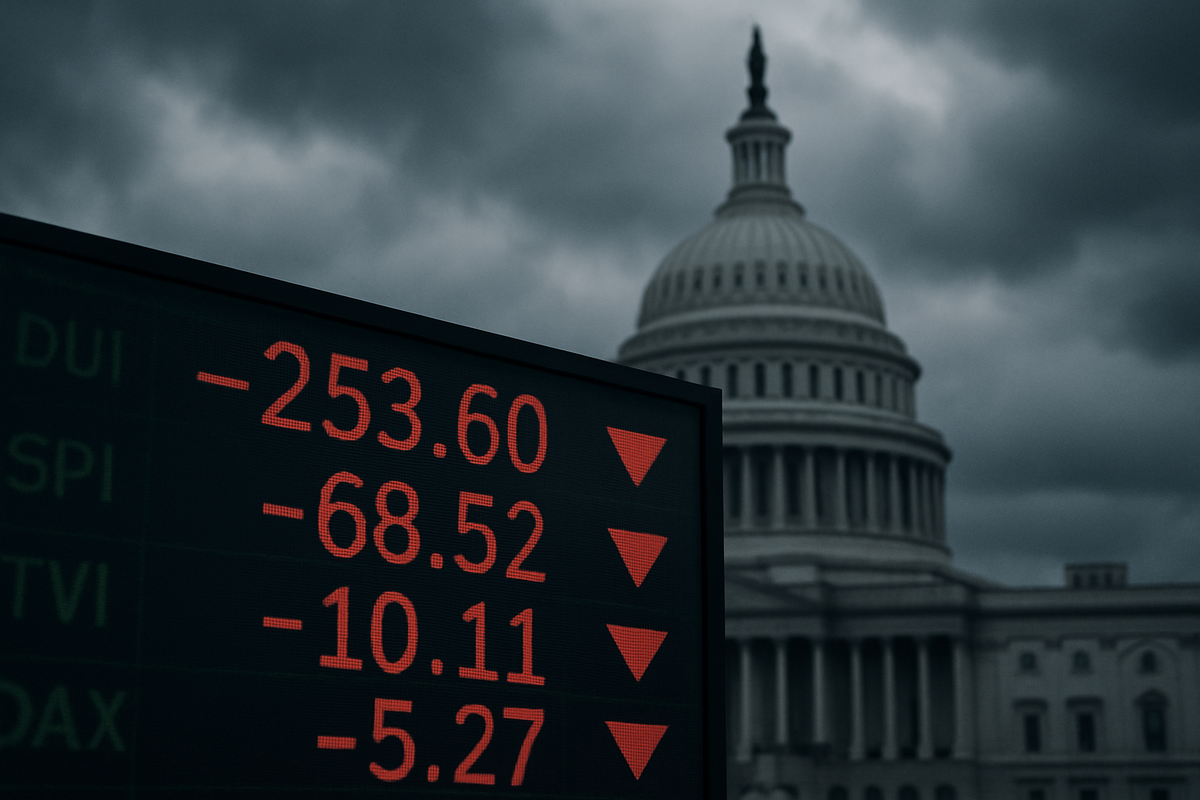
The ongoing U.S. federal government shutdown, now in its tenth day as of October 10, 2025, has sent significant tremors through global financial markets. The persistent congressional deadlock over appropriations legislation for the 2026 fiscal year has intensified economic uncertainty worldwide, contributing to notable market losses across major indices. As the world's largest economy grapples with internal political paralysis, investors are facing a perilous environment marked by delayed economic data, disruptions to critical government functions, and a palpable erosion of confidence in U.S. fiscal stability. This domestic turmoil, compounded by existing global trade tensions and a backdrop of slowing global growth, is challenging the resilience of an already sensitive international economy.
Detailed Coverage: A Deepening Crisis
The tenth day of the U.S. government shutdown on October 10, 2025, underscored the deepening impact of political gridlock on economic stability. The core of the issue lies in the failure of Congress to pass essential appropriations bills for the 2026 fiscal year, leading to a lapse in funding for numerous federal agencies and services. This legislative impasse has resulted in the furlough of hundreds of thousands of federal employees and the suspension of non-essential government operations. Key players in this ongoing saga include the White House, led by the current administration, and the leaders of both the House of Representatives and the Senate, who remain at odds over spending priorities and budgetary allocations.
The timeline leading up to this moment saw increasing tensions in the weeks prior to the October 1st fiscal year deadline. Despite last-minute negotiations, a failure to reach a consensus on spending limits and policy riders ultimately triggered the shutdown. Initial market reactions were somewhat contained, but as the shutdown extended into its second week, the cumulative effect began to manifest more severely. On October 10, 2025, major indices globally registered significant declines, reflecting a growing unease among investors. The US500 (NYSE: SPY), a proxy for the broader U.S. stock market, reportedly fell by 2.31% from the previous session, indicating a broad-based sell-off.
Beyond the immediate market figures, the shutdown's impact is deeply felt through the suspension or delay of crucial economic data releases. Agencies like the Bureau of Labor Statistics and the Census Bureau have halted the publication of vital statistics, including employment figures, inflation reports, and GDP data. This "data vacuum" creates an information deficit, severely hindering the ability of central banks, including the Federal Reserve, to make informed monetary policy decisions, and for investors to accurately assess market expectations. The erosion of trust in U.S. governance and fiscal stability internationally is also a significant concern, potentially deterring foreign investment and prompting a reallocation away from U.S. assets.
Corporate Fortunes in the Crosshairs
The prolonged U.S. government shutdown creates a distinct landscape of winners and losers among public companies, primarily dictated by their reliance on government contracts, regulatory approvals, or consumer confidence. Companies heavily dependent on federal contracts, particularly in defense, IT services, and infrastructure, face immediate revenue disruptions and project delays. For instance, major defense contractors like Lockheed Martin (NYSE: LMT) and Raytheon Technologies (NYSE: RTX) could see payments for ongoing projects delayed, impacting their cash flow and potentially their quarterly earnings reports. Similarly, IT service providers to federal agencies, such as Leidos (NYSE: LDOS) or Booz Allen Hamilton (NYSE: BAH), might experience a slowdown in new contract awards and a pause in existing non-essential work.
Conversely, some sectors and companies might indirectly benefit from the flight to safety. Gold mining companies, such as Barrick Gold (NYSE: GOLD) or Newmont (NYSE: NEM), often see their stock prices rise as investors flock to the precious metal during times of heightened uncertainty, as gold surged past $4,000/oz before a slight retreat on October 10, 2025. Companies offering essential services that are less tied to government functions or those with robust international revenue streams might prove more resilient. However, the overall dampening effect on consumer and business confidence could still ripple through most sectors, reducing discretionary spending and investment.
The shutdown's effect on regulatory processes is also critical. Companies awaiting approval for new drugs from the FDA, environmental permits from the EPA, or export licenses from the Department of Commerce could face significant delays. This directly impacts sectors like pharmaceuticals (e.g., Pfizer (NYSE: PFE), Johnson & Johnson (NYSE: JNJ)), biotechnology, and manufacturing, potentially postponing product launches and revenue generation. The Committee on Foreign Investment in the United States (CFIUS) also faces significant delays in processing reviews, which could stall international mergers and acquisitions, affecting global financial institutions and multinational corporations.
Wider Significance and Historical Context
The current U.S. government shutdown fits into a broader trend of increasing political polarization and fiscal brinkmanship in advanced economies, particularly in the United States. This recurring inability to pass routine appropriations bills without significant political drama undermines global confidence in the stability and predictability of U.S. economic policy. It signals to international partners and competitors alike a weakness in governance that could have long-term implications for the U.S. dollar's role as the world's primary reserve currency and the attractiveness of U.S. Treasury bonds as a safe haven.
The ripple effects extend far beyond American borders. Companies in allied nations that rely on trade with the U.S., or those with supply chains deeply integrated with American industries, face heightened uncertainty. For instance, European and Asian automotive parts manufacturers exporting to the U.S. might see demand soften if U.S. consumer confidence declines. Regulatory delays also affect global businesses, as approvals for international trade, mergers, and drug trials are stalled. Historically, past shutdowns, while often having a limited immediate impact on GDP due to recouped lost activity, have nonetheless created significant administrative burdens and eroded trust. This current shutdown, particularly given the fragile global economic environment, risks a more profound and lasting impact on international perceptions of U.S. economic leadership.
The estimated impact of trimming 0.1% to 0.2% from annualized U.S. GDP growth for each week of the shutdown, due to reduced government activity and dampened discretionary spending, highlights the direct economic cost. While much of this activity is typically recouped, the specter of potential permanent job cuts, as hinted by some administrations, introduces a new, more severe dimension. This raises concerns about a sustained drag on economic growth, differentiating it from previous shutdowns where the expectation of full recovery was more certain. The concurrent issues of slowing global growth and geopolitical risks further amplify the significance of this domestic political event on the international stage.
What Comes Next: Navigating the Uncertainty
In the short term, the market will remain highly sensitive to any news regarding negotiations between the White House and Congress. A swift resolution would likely trigger a relief rally, with indices recovering some of their losses as economic data flows resume and confidence is partially restored. However, a prolonged stalemate beyond mid-October could lead to further market depreciation, increased volatility, and a deeper flight to safe-haven assets. Investors should closely monitor statements from congressional leaders and the administration for any signs of compromise or escalation. The potential for the Federal Reserve to issue statements regarding the economic impact of the shutdown on monetary policy decisions will also be a key watch point.
Longer term, if these shutdowns become a more frequent occurrence, it could fundamentally alter how international investors perceive U.S. assets. This might lead to a sustained shift away from U.S. equities and bonds, potentially weakening the dollar and increasing borrowing costs for the U.S. government. Companies may begin to factor in political instability when making investment decisions, potentially diverting capital to more predictable markets. Strategic pivots for businesses might include diversifying supply chains away from heavy reliance on U.S. regulatory approvals or government contracts, and increasing resilience to domestic policy shocks.
Emerging market opportunities or challenges could also arise. If U.S. assets become less attractive, some investors might seek opportunities in more stable or rapidly growing emerging markets, although these also carry their own risks. The challenge for the U.S. economy will be to demonstrate its ability to overcome political divisions and ensure fiscal stability, or risk ceding its economic leadership on the global stage. Potential scenarios range from a quick, face-saving deal that minimizes long-term damage, to a protracted impasse that leads to a significant economic downturn and a lasting blow to U.S. credibility.
Comprehensive Wrap-Up: A Test of Resilience
The U.S. government shutdown on October 10, 2025, serves as a stark reminder of the interconnectedness of political stability and economic prosperity on a global scale. Key takeaways from this event include the immediate negative impact on market sentiment, leading to significant losses across major indices like the US500, and the surge in demand for safe-haven assets such as gold. The "data vacuum" created by the cessation of government reporting further complicates economic analysis and decision-making for both policymakers and investors.
Moving forward, the market will remain highly reactive to the political developments in Washington D.C. Investors should assess their portfolios for exposure to sectors heavily reliant on government functions or regulatory approvals. The resilience of public companies with diversified revenue streams and less dependence on the U.S. federal government will be tested, while those in counter-cyclical or safe-haven industries may experience continued interest.
The lasting impact of this shutdown will depend on its duration and the perceived ability of the U.S. political system to avoid similar impasses in the future. A pattern of recurring shutdowns could fundamentally undermine global confidence in U.S. fiscal management, potentially leading to a long-term re-evaluation of U.S. assets and the dollar's international standing. What investors should watch for in the coming months are not only the immediate legislative outcomes but also any signs of structural changes in political discourse that could prevent future shutdowns, or conversely, indicate a deepening of political dysfunction. The world watches as the U.S. navigates this critical test of its economic and political resilience.
This content is intended for informational purposes only and is not financial advice





